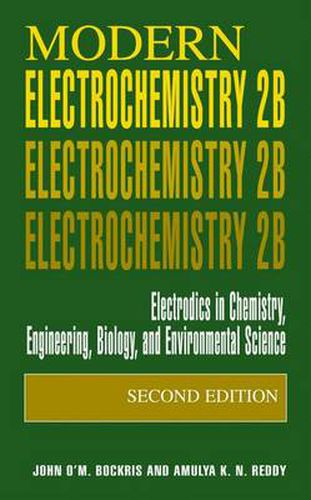Readings Newsletter
Become a Readings Member to make your shopping experience even easier.
Sign in or sign up for free!
You’re not far away from qualifying for FREE standard shipping within Australia
You’ve qualified for FREE standard shipping within Australia
The cart is loading…






This title is printed to order. This book may have been self-published. If so, we cannot guarantee the quality of the content. In the main most books will have gone through the editing process however some may not. We therefore suggest that you be aware of this before ordering this book. If in doubt check either the author or publisher’s details as we are unable to accept any returns unless they are faulty. Please contact us if you have any questions.
This updated version of the classic text (Plenum Press, 1970) explains the subject of electrochemistry in clear, straightforward language for undergraduates and mature scientists who want to understand solutions. Like its predecessor, the new text presents the electrochemistry of solutions at the molecular level. The second edition takes full advantage of the advances in microscopy, computing power, and industrial applications in the quarter century since the publication of the first edition. Such new techniques include scanning-tunnelling microscopy, which enables us to see atoms on electrodes; and new computers capable of molecular dynamics calculations that are used in arriving at experimental values. Chapter 10 starts with a detailed description of what happens when light strikes semi-conductor electrodes and splits water, thus providing in hydrogen a clean fuel. There have of course been revolutionary advances here since the First Edition was written. The book also discusses electrochemical methods that may provide the most economical path to many new syntheses - for example, the synthesis of the textile, nylon. The broad area of the breakdown of material in moist air, and its electrochemistry is taken up in the substantial chapter 12. Another exciting topic covered is the evolution of energy conversion and storage which lie at the cutting edge of clean automobile development. Chapter 14 presents from a fresh perspective a discussion of electrochemical mechanisms in biology, and chapter 15 shows how new electrochemical approaches may potentially alleviate many environmental problems.
$9.00 standard shipping within Australia
FREE standard shipping within Australia for orders over $100.00
Express & International shipping calculated at checkout
Stock availability can be subject to change without notice. We recommend calling the shop or contacting our online team to check availability of low stock items. Please see our Shopping Online page for more details.
This title is printed to order. This book may have been self-published. If so, we cannot guarantee the quality of the content. In the main most books will have gone through the editing process however some may not. We therefore suggest that you be aware of this before ordering this book. If in doubt check either the author or publisher’s details as we are unable to accept any returns unless they are faulty. Please contact us if you have any questions.
This updated version of the classic text (Plenum Press, 1970) explains the subject of electrochemistry in clear, straightforward language for undergraduates and mature scientists who want to understand solutions. Like its predecessor, the new text presents the electrochemistry of solutions at the molecular level. The second edition takes full advantage of the advances in microscopy, computing power, and industrial applications in the quarter century since the publication of the first edition. Such new techniques include scanning-tunnelling microscopy, which enables us to see atoms on electrodes; and new computers capable of molecular dynamics calculations that are used in arriving at experimental values. Chapter 10 starts with a detailed description of what happens when light strikes semi-conductor electrodes and splits water, thus providing in hydrogen a clean fuel. There have of course been revolutionary advances here since the First Edition was written. The book also discusses electrochemical methods that may provide the most economical path to many new syntheses - for example, the synthesis of the textile, nylon. The broad area of the breakdown of material in moist air, and its electrochemistry is taken up in the substantial chapter 12. Another exciting topic covered is the evolution of energy conversion and storage which lie at the cutting edge of clean automobile development. Chapter 14 presents from a fresh perspective a discussion of electrochemical mechanisms in biology, and chapter 15 shows how new electrochemical approaches may potentially alleviate many environmental problems.